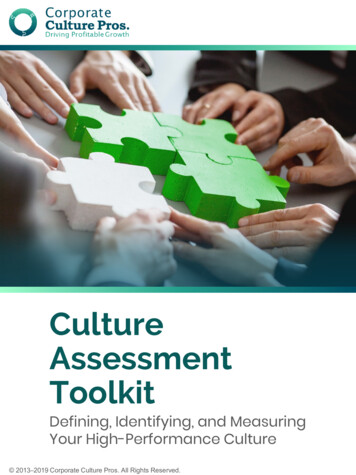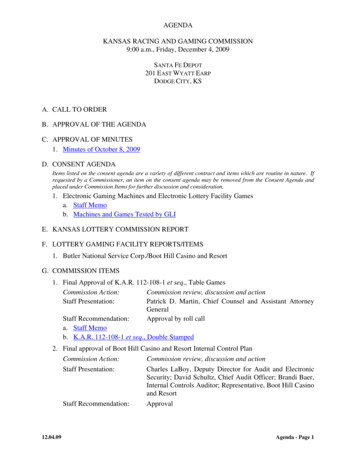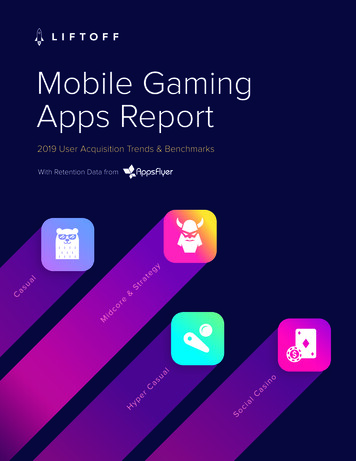
Transcription
Center ReportA Look at Gaming Culture and Gaming Related Problems:From a Gamer’s PerspectiveBy Daniel Fu, with Center Staff Assistance*Part I: Personal ExperiencePart II: A Brief Look at Gaming History, Terminology, and DemographicsPart III: Gaming DisorderPart IV: Gaming Toxicity, Online Disinhibition, and CyberbullyingPart V: Misogyny in the Online Gaming CommunityPart VI: About Helping Those AffectedA Final Personal CommentReferences*This report is an amended version of a special project report by Daniel Fu.It conveys his personal experiences, literature research, and current understanding.The project was done as part of Daniel’s involvement with thenational Center for MH in Schools & Student/Learning Supports.The center is co-directed by Howard Adelman and Linda Taylor in the Dept. of Psychology, UCLA,Website: http://smhp.psych.ucla.edu Send comments to ltaylor@ucla.edu0
Part I: Personal Experiencey interest in understanding video game addiction (particularly competitive online multiplayergames) and their effect on mental health and mental wellness among teenagers and youngadults stem from my own experience and addiction to gaming in the past. Growing up myparents didn’t allow me to play games until around late middle school. During high school I wasextremely addicted to online multiplayer video games, in particular League of Legends. Thiswas only possible due to my ability to access a computer on a regular basis.When I was still in elementary school and even in middle school, games were mostly confinedto consoles made by Nintendo, Play Station, or Xbox. Games were also very expensive, whichincreased the barrier to entry for someone like me who didn’t have money to buy anythingmyself. Once I was in high school and had a computer to use, free-to-play (F2P) games suchas League of Legends quickly became one of the main past times for me and my friends due toits accessibility. Additionally, smart phones became more and more popular during that time, somobile games were also a source for my gaming addiction, but to a lesser degree.Video games in general are fun and stimulating to play. Multiplayer games allow people toexperience the thrills of competition in a leisurely environment. Additionally, many games allowusers to connect with other people online (both friends and strangers), without having to leavethe comforts of home. Being able to hang out with friends in a virtual space is an appealingreason for many students to play video games. I have a lot of good memories of playing bothconsole games and online multiplayer games with my friends. Despite this, during my highschool years and even now when I play occasionally, I can’t help but notice how addictive thegame can feel, and I worry about the “toxic culture” I see during games and in the gamercommunity as a whole.Video games can heavily influence one’s emotion; I often felt a disproportionate amount ofanger and frustration when I played (compared to my other activities). Video game addictionand toxicity also impacted the lives of my friends. For me and most of my friends, our addictionstemmed initially from our competitive nature. We loved to win and hated to lose. It also was anescape from the stress and pressure we felt from school and other extracurricular activities.Eventually, we played multiple hours almost every day. Gaming became a lifestyle soengrained, that our daily and school lives were greatly impacted. I often fell asleep in classbecause I had played video games until 3 or 4 a.m. And, I didn’t do my homework because Iwas spending all my time gaming. One of my friend’s addiction to gaming led him to adownward spiral where he skipped classes and ultimately had to drop out of school.Since multiplayer online gaming is a relatively new trend, many teachers in schools may notfully grasp the problems associated with video gaming and the gaming community/industry.While games often get a bad reputation for problems they don’t necessarily cause, manyunderlying problems are overlooked.My gaming world experiences seriously impacted my life and the lives of those around me, andas a result, I wanted to take a deeper look at the negative aspects of gaming that can lead tolifestyle imbalances and have an effect on academic performance and quality of life. Thisreport gives an insider’s perspective on gaming community and culture with the goal providingparents and teachers with a better understanding of positive and negative effects. Hopefully theinformation will allow those in leadership/mentoring roles to be better informed about gamingculture so they can help gamers achieve a more balanced lifestyle.1
Part II: A Brief Look at Gaming History, Terminology, and Demographicsn an age where the internet and technology have made startling advancements, internetabuses and addiction are significant problems for many. The problems arise on manyplatforms (e.g., YouTube, social media, gaming, etc.). The focus here is on video gaming.While video games, in particular online games, often are lumped together with other internetaddiction problems, there are nuances that frequently are overlooked or misunderstood.In the past video games were primarily confined to console systems such as the NintendoEntertainment System, Plays Station, Gameboy, etc. Nowadays, video games have expanded toother platforms such as computers and smart phones. Many games include competitive, online,and multiplayer features. Over the past 20 years, games like StarCraft, World of Warcraft, Leagueof Legends, Defense of the Ancients (DotA), Count-Strike Global Offensive (CS:GO), Minecraft,Overwatch, and Fortnite (to name a few) have become some of the most popular onlinemultiplayer games.Until recently, video games were closely associated with nerd and geek culture. However, withthe increase in popularity of Fortnite within the past two years, the gaming community haschanged noticeably to include people who, in the past, would not be associated with the gamercommunity. Celebrities ranging from rappers to sport stars such as Drake, Juju Smith-Schuster,and Luka Doncic all play Fortnite. Having celebrities frequently featuring gameplay on theirsocial media has changed how many people view video games. Online multiplayer games arebecoming even more mainstream, and kids often play these games to keep up with the trends.(Note: since young people tend to look for the “next cool thing,” the lifespan of online gamesseems to be getting shorter and shorter.) While the demographics of the gaming community hasexpanded, most of the fundamental issues that are ingrained in the “gaming culture” and the onlinemultiplayer experience have not.A Bit of History and TerminologyAt first, video games were mostly single player and games on early console systems and werepredominantly story driven. These games often featured fantastical elements that would immerseplayers into the gaming world, not unlike a novel. Although attempts to add network (internet)features to consoles occurred throughout the 1990’s, online multiplayer gaming on consolesbecame significantly more common after the introduction of Xbox Live in 2002. Online gamingon computers also occurred in the late 1990’s with games like Starcraft and Counter Strike. Andwithin the last 10 years, mobile gaming on smartphones and tablets also has increaseddramatically. The most common online types of multiplayer games are: massively multiplayeronline (MMO) role-playing games (RPG) (often abbreviated as MMORPG), first person shooter(FPS), real-time strategy (RTS), multiplayer online battle arena (MOBA), and, more recently,battle royale/survival genre.Additionally, many fighting games, sport games, and even puzzle games initially confined tocouch co-op (i.e., two players on one console) now have internet capabilities, which allow playersto compete with strangers online. These online multiplayer games fall into one of two categoriesPvE (Player vs Environment) and PvP (Player vs Player). The former is often found inMMORPGs or some shooters where players work together to fight computer-controlled enemies.While MOBA, FPS, RTS, and battle royale games mainly feature a competitive PvP environment,many games often contain both PvE and PvP capabilities. Below is a conceptual map of somemain gaming genres taken from “The Benefits of Playing Video Games” by Grancic, et al (2014).My report focuses mostly on genres located in the top right section of the figure, especiallycompetitive genres that require cooperation like MOBAs.2
The way games have been monetized also has changed throughout time. In the past, most games weresold containing all content for a single payment. Currently, many online games are free-to-play (orhave a relatively cheap cost), but embed in-game purchases that unlock new content, special itemsand perks, cosmetic items, and loot boxes. This trend has resulted in more people trying a game, andit enables game developers to hook more users. Games such as League of Legends and Fortnite usethis process, which is a reason that their player base is so large. This business model has become thestandard in the gaming industry and can be seen in the mobile game industry as well (and even withnon-game apps).Male/Female DemographicsWhen talking about gamer male and female demographics, it is important to note the differencebetween core gamers and casual gamers. Core gamers are made up of people who view gaming as ahobby or lifestyle. These people are extremely invested in gaming and spend most of their free timeplaying. When not actually playing, they often are reading about games or watching videos or livestreams about games. Within the core gamer demographic, are hard-core gamers (i.e., those who areobsessed with gaming). Casual players don’t play as often and usually play only mainstream gamesor just mobile games. Core gamers usually don’t view casual gamers as real gamers and callingsomeone a “casual” frequently is meant as an insult.According to Entertainment Software Association’s 2018 recent report, 45% of gamers in the U.S.are female. However, among core gamers, males dominate, making the female statistic somewhatmisleading. Moreover, the best estimates are that the most severe gaming problems generally involveyoung males. And, perhaps because of the disproportionate amount of male hard core players,misogyny is a frequent facet of game content and throughout the gaming community. Sexism and3
inappropriate behavior towards females are commonplace. Players appear to conform to stereotypicalmasculine norms and tend to maintain a male dominant hierarchy. (It shouldn’t be a surprise thatnearly all pro gamers are men.) For more on these demographics, see the appended information andgraphs.Ranking SystemsAnother aspect to understand about many online multiplayer games are player rankings. Games ofteninclude a ranking feature to further increase the game’s competitiveness. Many video games awardspecial items or badges that can be used in-game. Players tend to take great pride, often using theirrank as a status symbol, and dominance hierarchies are common within groups of ranked players.Systems ranking players are based on win records and originate from the Elo rating system that wasinitially created for chess. The system’s main goal is to predict the outcomes of games based on howplayers are rated. When a higher rated player wins against a lower rated player (since this outcomewas predicted), the higher rated player earns fewer rating points, and the lower rated player losesfewer points. If the lower rated player wins, the reverse is true. The aim is to move toward a ratingthat accurately reflects an individual’s level of play.Once a player has reached his/her current potential, then the player technically should not be able toclimb higher and should experience a 50/50 win-loss ratio over a stretch of time. If the player is ableto further improve on “rated/ranked” games, then their ranking self-corrects. This process of playingmany games to move into a higher rank/rating is called “climbing” (sometimes players will also usethe words “grinding to [a designated rank]”).Most gamers, even self-proclaimed casuals, care about how others perceive their rank, even if theydon’t actually care about the particular game itself. Because of this, many players succumb to formsof cheating, match fixing, or Elo boosting to get a higher ranking. (Elo boosting is when a player hassomeone of higher rank play their account in order to climb to a higher rating quickly.) Some gamersclaim they are better than their rank suggests, and blame the system for making the climb difficult ortedious. Such cheating and blaming angers honest players, and it is not surprising that rank is thenumber one reason behind cyberbullying in games (Ballard & Welch 2017).4
Part III: Gaming Disorderenerally, when non-gamers think about gaming-related problems, the first thing that comes to mindis gaming addiction. Parents, in particular, are most concerned about this.Casual gamers get mislabeled as “addicts” when they have developed a habit of playing games to killtime. Hard core gamers become addicted to games when it becomes a lifestyle consuming everyaspect of their life.Gaming disorder has become a designated mental disorder, with increasing attention over the pastten years (Wang & Lin, 2018). In 2014, Internet gaming disorder was added to the research appendixof the Diagnostic and Statistical Manual of Mental Disorders 5th Revision (DSM-5) as the only nonsubstance addiction (Petry et al., 2014). (Gambling disorder was moved to the substance use disordercategory.) In 2018, gaming disorder was also recognized by the World Health Organization as amental illness and has since been added to the 11th revision of International Classification of Diseases(ICD-11) (Rogers, 2018).Gaming Disorder CharacterizedGaming disorder is defined as behavior “characterized by impaired control over gaming, increasingpriority given to gaming over other activities to the extent that gaming takes precedence over otherinterests and daily activities, and continuation or escalation of gaming despite the occurrence ofnegative consequences” (World Health Organization, 2018). Petry, et al. (2014) state that, unlikegeneral internet addiction, gaming disorder clearly shows an increase in risk for clinically significantissues. It has been associated with food and sleep deprivation, seizures, and even death among youths.Another study concluded that online gamers who played for more than five hours on a weekday hadincreased depressive symptoms, musculoskeletal symptoms (e.g. shoulder, back, and hand pain), andpsychosomatic symptoms (e.g. headache, feelings of nervousness, irritation, and sleep problems)(Hellström et al., 2015).Victor Fornari, a child and adolescent psychiatrist, states that “aggressive games involving teamworkand killing enemies tend to be the most addictive for young people” (reported in Rogers, 2018). Notethat his description of gaming genre closely matches MMORPG, MOBA, and online shooter genres.Research suggests that some youngsters classified as pathological gamers turned to games because offamily conflict, neglect, or abuse (Da Charlie et al., 2011).Hooking PlayersWhile part of the addiction problem can be blamed on player problems and deficiencies (e.g., lack ofself-control, poor time-management), developers of online games have embedded many featuresspecifically to hook players. As mentioned, using the free-to-play business model attracts players.Once a person has chosen to play, game developers use multiple psychological tactics to keep themplaying and buying “virtual goods.” For example, a common tactics is endowment progress. Thisinvolves providing players with artificial advancement in the game to enhance persistence (e.g.,giving experience points or XP that help the player “level up”). Many gaming companies also placeincentives along the way, such as a small reward every time a task is completed or a character/gamingaccount for leveling up. This tactic also rewards players for being loyal to a game and discouragesplayers from leaving the game and having to start over again (Nunes & Drèze, 2006a, 2006b). Many5
games also move “goal posts” where the game either keeps expanding so players can never really winor finish the game (this occurs in MMORPGs), or the game has seasons that reset everyone’sprogress/rank at the beginning of each cycle (found in MOBAs, online FPS, and battle royale genres).This makes it hard for players to stop gaming and can be compared to Facebook’s infinite scrollfeature that makes it difficult for users to stop scrolling (Fishman, 2018).Adar (2015) has highlighted 7 psychological tactics used in games to hook users. He states:Gaming companies also incentivize players to buy many in-game cosmetic items by makingthem seem extremely appealing, or by artificially manufacturing an item’s rarity/exclusivity.Additionally, many game developers use a loot box system that allows players to purchase,for all intents and purposes, a chance to get something (usually items) rare or desirable.This particular aspect of gaming is no different from gambling, and many countries haverecognized this and taken steps to regulate this aspect of game.Long gone are the days where games could just be great in order to generate revenue. Now,since 90% of games on the app store and Google Play are free, being a great game isn’tgood enough. Games must be addictive, habit forming and mind–boggling, so they can riseto the top over a myriad of other great, free games who compete on users’ free time.Only games that encourage users to engage and spend regularly can survive.As such, current successful F2P games are a brew of persuasion techniques designed toachieve uncompromised engagement. Here’s a short list of the most notorious persuasivemethods and psychological tactics that are used in games: Endowed Progress, LossAversion, Envy, Reciprocity, Scarcity, Triggering, and Endowment Effect.The increased attention to gaming as a problem around the world has led to recommendations thatparents and school personnel restrict and more closely monitor gaming behavior (Rogers, 2018). Italso has generated government regulation.Government RegulationKorea and China illustrate government efforts to regulate the gaming habits of youth or pressuregaming companies to include features that deter gaming addiction. In these countries, in order to playonline games, players are required to register and verify their identity. This measure is taken to keeptabs on gamers who are minors.In Korea for example, the Youth Protection Revision Act was passed in 2011which prevents thoseunder age 16 from playing video games between 12:00 a.m. and 6:00 a.m. (Lee, 2011).In China, many large gaming companies are pressured into implementing an “anti-addiction system”for teenagers under the age of 18. This involves tracking the gamer’s play time to a set limit, afterwhich, the gamer no longer can make significant progress or receive in game rewards (South ChinaMorning Post, 2017). Recently, China has also taken major steps to regulate gaming content andinternet access for youths (Niko, 2017; South China Morning Post, 2018).In reaction, young people have used a number of strategies to work around the limitations, such ascreating multiple game accounts and identity theft.6
Without restrictions, computer games afford kids the ability to sneakily play video gameswithout parents noticing. Many gamers, including myself, would switch the game screen veryquickly (using Alt Tab or Command Tab controls on PC and Mac, respectively) to pretend wewere being productive on our computers when parents came to check.One common question that non-gamers might ask is why gamers take games so seriously. The realityis that for many gamers their whole life has become invested in the games. Most of their friends play,and an in-game identity/reputation sometimes becomes worth more than one’s real-world status. Thismakes game playing a high stakes event and a priority commitment.To a causal player or observer, losing a game is just losing a game. But for hard core gamers, losingundermines their reputation and ranking. This not only increases the stakes of playing, but contributeto the vicious cycle of addicted game playing.Furthermore, gaming allows people to escape from the real world. While gaming brings a sense ofsatisfaction to non-addicted players, one study suggests that gaming for addicted players is a way torelieve themselves of dissatisfaction in their daily life (Wan & Chiou, 2006).In my own experience, gaming disorder has led to sleep deprivation throughout my high schoolyears, as well as poor academic performance, eating habits, physical activity, and overall mentalwellness. I was so addicted to games that basically during all my free time, the only thing I wouldthink of was video game related things.I remember being so consumed by my desire to play video games that I would have a lot ofarguments with my parents, and I would also sneak in game time. Like any other addiction, Ineeded to get my “fix” at all costs, and if someone tried to take it away from me, I would becomeirrationally angry.Another problem I experienced was letting the game affect me emotionally. My in-gamefrustration would often bleed into my daily life and caused me to be extremely moody. Myperformance in-game would also affect my own perception of self-worth, since gaming wasbasically what defined me during high school.Many of my friends experienced these exact same issues, with some facing even greater mentaland academic consequences due to this gaming addiction. One of my friends in high school gotinto to so many arguments with his parents over gaming that he actually ran away from home fora week, which seems extreme but shows that gaming disorder is not to be ignored. I’ve alsoseen elementary school kids throw temper tantrums when their parents take away the iPad orcell phone and tell the kids to stop playing mobile game. Clearly, growing gaming prevalencehas increased the risk for children to develop gaming disorder at a relatively young age.7
Sunk Cost Fallacy for Competitive Online GamesOne often overlooked factor that causes or worsens gaming addiction is the sunk cost fallacy. Becausemany competitive games implement a ranking system, players who lose frequently continue to playin hopes of attaining more wins or and improving their rank. This behavior, which is basically thepractice of loss aversion, can really spiral out of control, especially when combined with theendowment progress effect mentioned above (Adar, 2015).From personal experience during high school and my first year in college, I know that it’sextremely embarrassing to admit to people that your rank is only silver (second worst rank at thetime, third worst now) although you’ve been playing basically every day after school. It’s likeadmitting that you’re bad at the game even though you’ve invested so much time and energyinto it.I have witnessed people succumbing to the pressure of performing well countless timesthroughout the years, and everyone knows that this is one of the biggest reasons why playerskeep playing even if they don’t really enjoy or care for the ranked system. For example, when Ifirst came to UCLA, my roommate and I decided to check out the League of Legends club. Allthe people who showed up were quite invested in the game. During the first social event, myroommate and I would ask what people’s ranks were. Most people would embarrassingly statethat they were only in silver or bronze because they just played the game casually, when manylikely had put a lot of time into the game.This type of pressure created by the rank system and the shaming/teasing of players who aren’tranked high not only creates an environment that can foster toxicity, hurt feelings, andembarrassment, but also can make people obsess over their rank. This often results in themputting more time into playing in hopes of improving their rank and legitimize the time and effortthey put into the game.My brother personally, experienced this exact obsession when he wanted to get Diamond (oneof the highest ranks) in a game to prove to others and to himself that he was good at the gameafter playing it for years. During the phase when he was most addicted, the anger and frustrationhe experienced from gaming had serious repercussions. During his “grind” to diamond, he putoff doing homework, he skipped classes due to late nights of gaming, and he appearedemotionally unstable when he lost too many games and got demoted a few ranks. Additionally,the more games he lost, the worse he played. This, however, only made him want to play moreto either break even or not get demoted. He was in a vicious cycle where he put more and moretime into the game while only getting worse, and this made him feel terrible about himself.I am confident in saying that a good portion, if not the majority, of hard-core players who caredeeply about their rank experience similar problems and frustration and anger as they losegames and struggle in climbing.Fueled by the sunken cost fallacy and a rank system that only allows a skilled minority to makesubstantial and satisfactory progress, hundreds of thousands of players are “hard stuck” in an addictivecycle. For example, around 50% of the player base in League of Legends (and other online games)are usually in silver rank or below (or the equivalent Elo for other games). Due to the nature of theElo/rank system, a large number of average players never make satisfactory progress because theyalready have reached their maximum potential.8
Even now, as a player who doesn’t care aboutr my rank anymore, if I lose multiple games in arow, I can’t help but want to play more to either break even (in terms of wins vs losses) or at leasttry and get one win before I end my gaming session. A typical scenario::I want to play one game with my friend before I go to bed, and the game goes poorly,and we lose. My friend says that we can’t end on a loss, so we play another gamewhere we lose again. This time we tell ourselves that we’ll just play one more and if welose we’ll stop. After we lose the third time, we conclude that we’ve already put too muchtime into gaming to end on such a bad note. We continue playing, sometimes foranother 2 to 3 games until we get our first win. At this point, it is many hours past bedtime.Although we finally attained the goal of winning, which was supposed to give us a senseof satisfaction, the reality of the situation is that we have reduced the amount of sleepthat night, with an impact on the next day. More often than not, we feel pretty upset byabout our poor decisions. This cycle is worsened when winning no longer bringshappiness.Many people play games just out of habit. Winning doesn’t really trigger much positive emotion,however losing usually triggers negative emotions. As a result, playing video games at this pointbecomes a lose-lose scenario for many gamers.9
Part IV: Gaming Toxicity, Online Disinhibition, and Cyberbullyinghile parents and teachers mainly focus on gaming addiction, toxic events that occur during gamesand in the gaming community can have negative outcomes on a young gamer’s well-being.Toxicity in games usually takes the form of abusive or negative language or behavior. In effect, thisis cyberbullying (Blackburn & Kwak, 2014). Studies have shown that toxic language is found in 60%of matches for League of Legends and is “fueled by the inherent competitiveness of MOBA games”(Märtens et al., 2015). Researchers also have found that toxic language varies as the game progressesand it becomes clearer which team is going to win (Märtens et al., 2015). During the late stages of agame, the winning team usually experiences less toxicity, while the “need to shame and blameteammates” is much greater for the losing team (Märtens et al., 2015).In many team games, voice chats are used to allow team communication and strategic coordination.However, because games often match up strangers online, intra-group conflicts arise, especially whenthe team is struggling (Kwak et al., 2015). As a result, chatting features also enable teammates to“flame” (verbally abuse) each other for either “messing up” or doing poorly. Players who play well(are ranked high) or think they are really good usually speak from a position of dominance and oftentaunt and harass other players for their poor performance. For MOBA/FPS gamers, this becomes arite of passage, where beginners (noobs) are flamed/blamed when they first learn the game (despitethe high complexity and learning curve for these games). And when the beginners improve, theyusually feel like they now have the right to cyberbully others.Another way in-game toxicity arises is through direct gameplay. For example, sometimes playersintentionally play poorly so that the entire team loses or at the very least experiences difficulty(sometimes just for fun or because they are giving up). This behavior is usually called intentionallyfeeding or inting, for short. Some players even “rage quit” mid-game and leave teammates on unevenfooting against the opposing team. All these behaviors can cause players on a team to be extremelyfrustrated and upset and can lead to more toxic behavior.About Online DisinhibitionSuler (2004) presents a reasoned view of the positive and negative facets of the online disinhibitioneffect. He describes the phenomenon as one where internet users “say and do things in cyberspacethat they wouldn’t ordinarily say and do in the face-to-face world. They loosen up, feel less restrained,and express themselves more openly.”Benign disinhibition is seen as causing people to do relatively positive things, such as openly engageor do random acts of kindness. Toxic disinhibition is when internet users wield offensive language ordisplay acts of anger and hate. (The tendenc
climb higher and should experience a 50/50 win-loss ratio over a stretch of time. If the player i











